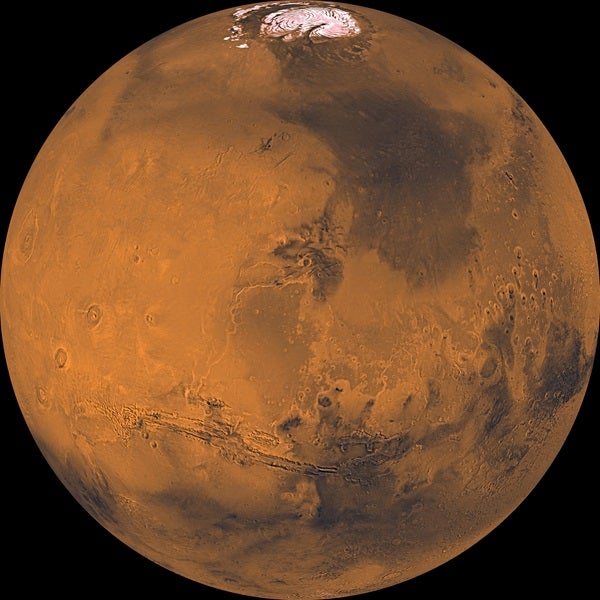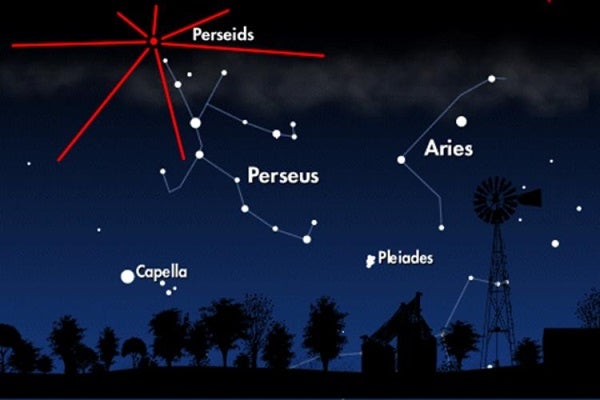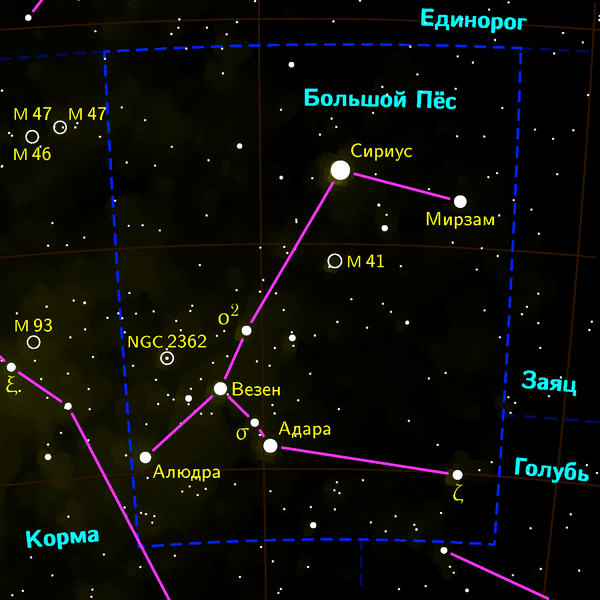Friday, August 5
- A slender crescent Moon stands 1° below Jupiter in this evening’s sky. Look for the soft glow of earthshine — sunlight that has reflected off our planet to the Moon and then back to our eyes — on the 90 percent of our satellite that the Sun does not illuminate directly. Jupiter shines brilliantly at magnitude –1.7 and remains a beacon in the western sky after sunset all week. When viewed through a telescope, the giant planet shows a disk that measures 32″ across and features two dark equatorial cloud belts.
Saturday, August 6
- The variable star Algol in Perseus reaches minimum brightness at 5:33 a.m. EDT. If you start watching it late yesterday evening (it rises in the northeast around 10 p.m. local daylight time), you can see its brightness diminish by 70 percent over the course of about five hours as its magnitude drops from 2.1 to 3.4. This eclipsing binary star runs through a cycle from minimum to maximum and back every 2.87 days.
Sunday, August 7
- Look toward the south-southwest as darkness falls and you can’t help but see Mars. The Red Planet shines brilliantly at magnitude –0.7 — brighter than every other object except for the Moon once Venus and Jupiter set during twilight — against the background stars of northern Scorpius. And it remains visible until it dips below the southwestern horizon after midnight local daylight time. When viewed through a telescope, Mars’ orange-red disk spans 12″ and shows a number of subtle dark markings.
Monday, August 8
- Once you’ve found Mars, shift your gaze 9° (the approximate width of your closed fist when held at arm’s length) to the upper left and you’ll be gazing at Saturn. The ringed planet shines at magnitude 0.4 and stands out against the surrounding stars of southwestern Ophiuchus. Adding to the scene is the ruddy 1st-magnitude star Antares in Scorpius, which appears 6° below Saturn. When viewed through a telescope, the planet measures 17″ across while its dramatic ring system spans 39″ and tilts 26° to our line of sight.
Tuesday, August 9
- Tonight and tomorrow night provide observers with an excellent opportunity to track down the 9th-magnitude asteroid Pallas. On these two nights, the second-largest object orbiting between Mars and Jupiter passes directly between Enif (Epsilon [e] Pegasi), the 2nd-magnitude star that marks the nose of Pegasus the Winged Horse, and the lovely globular star cluster M15. Almost any telescope will gather enough light to show you Pallas some 3° northwest of Enif and 1° southeast of M15. The trio lies about halfway to the zenith in the southeastern sky during late evening.
- The Moon reaches apogee, the farthest point in its orbit around Earth, at 8:05 p.m. EDT. It then lies 251,197 miles (404,262 kilometers) from Earth’s center.
Wednesday, August 10
- First Quarter Moon occurs at 2:21 p.m. EDT. By the time the Sun sets this evening for North American observers, the Moon appears in the south-southwest and more than one-third of the way from the horizon to the zenith. As darkness descends, our satellite grows more prominent and the background stars of Libra the Scales come into view.
Thursday, August 11
- The annual Perseid meteor shower reaches its peak tonight. In a typical year, observers under a clear dark sky can expect to see up to 100 meteors per hour. But astronomers think we may be in for an even better show this year because Jupiter recently nudged the debris stream from the Perseids’ parent comet, 109P/Swift-Tuttle, closer to Earth’s orbit. If predictions hold true, we could see up to 150 meteors per hour overnight. The best views will come in the predawn hours of Friday morning, after the waxing gibbous Moon sets around 1 a.m. local daylight time. The spectacle continues to improve as dawn approaches because the shower’s radiant — the spot on the border between Perseus and Cassiopeia where the meteors appear to emanate — climbs higher.
- If you’re looking for something to do while waiting for the Perseids to peak after midnight, watch this evening’s gibbous Moon as it forms a pretty and nearly equilateral triangle with Mars and Saturn. Our satellite stands 8° north of Mars and 7° northwest of Saturn, while 7° separate the two planets. The trio becomes prominent during twilight and remains on view until nearly midnight local daylight time.
Friday, August 12
- Assuming you watch the Perseid show this morning, don’t pack up when twilight starts to paint the sky. About 45 minutes before the Sun comes up, look for a bright object hovering just above the horizon in the east-southeast. This is the night sky’s brightest star, magnitude –1.5 Sirius in the constellation Canis Major. From mid-northern latitudes, the luminary climbs some 4° high a half-hour before sunrise and should stand out if you have a clear and unobstructed horizon. The return of Sirius to the predawn sky was an occasion for celebration in ancient Egypt. Around 3000 b.c., this so-called heliacal rising of Sirius heralded the coming flood of the Nile River, an event upon which agriculture — and all life in Egypt — depended.
Saturday, August 13
- Look overhead around 10 p.m. local daylight time any day this week and your eyes will fall on the brilliant star Vega in the constellation Lyra the Harp. At magnitude 0.0, Vega is the brightest member of the prominent Summer Triangle asterism. The Triangle’s second-brightest star, magnitude 0.8 Altair in Aquila the Eagle, lies some 35° southeast of Vega. The asterism’s dimmest member, magnitude 1.3 Deneb in Cygnus the Swan, stands about 25° east-northeast of Vega. Although the brightening Moon diminishes the luster of stars this week, the Summer Triangle remains conspicuous.
Sunday, August 14
- The two inner planets lurk low in the western sky shortly after sunset this week. If you scan the horizon through binoculars 30 minutes after sundown, you should pick up Venus standing just 4° high. It shows up only because in shines so brightly, at magnitude –3.8. Mercury appears at nearly the same altitude but will be much harder to see because it glows more dimly, at magnitude 0.2. This morning, the innermost planet lies 9° to Venus’ left and 6° to Jupiter’s lower right.












